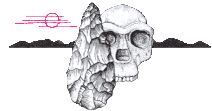Brain Imaging Studies of
Stone Toolmaking
What are the cognitive demands of making early stone tools? The manufacture and use of early stone tools represents a major evolutionary advance in the behavior of early hominids. Identifying any shifts in brain and cognitive function that may have been associated with this innovative behavior has long been priority in paleoanthropological research. Modern brain imaging techniques are now making it possible to address these questions directly.
The use of Positron Emission Tomography (PET) to examine patterns of brain activation during stone tool manufacture was pioneered in a pilot study of Oldowan tool-making by Stone Age Institute researchers Dietrich Stout, Nicholas Toth, and Kathy Schick, working with Julie Stout of the IU Psychology Department and Gary Hutchins of IU Radiology. This research was continued in a more systematic, multi-subject study by Dietrich Stout which revealed the unusual visual-spatial and motor demands of Oldowan tool-making and documented the changes in brain activation associated with skill acquisition. These results challenge accepted ideas about the psychological implications of the earliest stone tools and highlight those areas of the brain most likely to display evolutionary adaptations relevant to stone tool-making. More recently, Stout, Toth and Schick have completed a pilot study using PET to examine differences between Oldowan and later Acheulean stone tool-making, a project which will be expanded in the future.

Subject entering PET scanner


